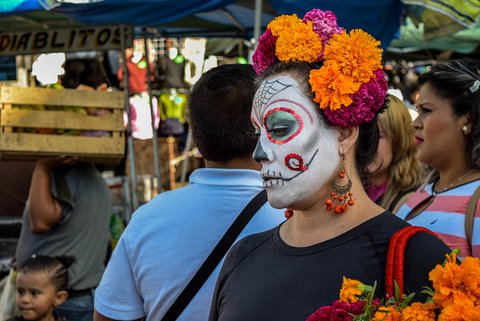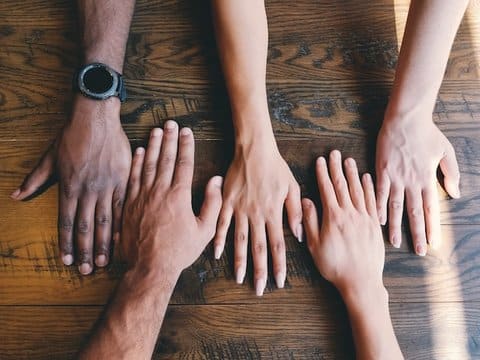
31 Oct I Hope This Día de Muertos Will Bring Me Closure

A woman commemorates Día de Muertos on the island of Janitzio in Michoacan, México. (“Rutina de muerto” by Juan Pablo González / Flickr / CC BY-NC 2.0 license)
Commentary, Mitzi Pérez-Caro
Día de Muertos is such an important day in the region of México my family is from, but when my grandparents brought their young families — including my parents — to the U.S., they just wanted to fit in. More recently, we’ve been reclaiming our culture, and its helped me connect with and celebrate my ancestry and honor loved ones who have died.
Día de Muertos occurs on Nov. 1 and 2 every year. Michoacan, the Pacific coast state in México that my maternal heritage originates from, has the most gorgeous displays and parades that celebrate the legacy of life. There are often floods of cempasúchils flowers and petals, folks dressed in calaveras, and monarch butterflies all over. Cempasúchil is the Aztec word for the marigold flower; calaveras are depictions of human skulls.
In the Michoacan island of Janitzio, alluring boats and lanterns guide visitors with infectious music to spend time with their loved ones during Día de Muertos. Loved ones bring offerings that are significant to the deceased.
>>>From Our Archives:
In Mexico, the Graveyards Are Most Alive on Día de los Muertos<<<
This is not a practice that my family brought from México with them to the United States. My parents were very young when their families migrated to California; my mom was only 7 when her family came from Chavinda, Michoacan, and my dad was 5. My grandparents did their best to assimilate their families to their new home. Their goal was to blend in to the culture that was surrounding them.
>>>From Our Archives:
Observing Dia de Los Muertos Is a Family Affair<<<
Unlike México, America does not have a day that celebrates the dead. So growing up, my sister and I were not introduced to the traditions of our ancestral region.
That has since changed. As I started to learn more about the history of my family, my current city and my origins, I felt more connected with my roots. As a journalist and teacher, I feel a strong pull to research the truth about my surroundings.
>>>From Our Archives:
Teaching During COVID Has Me More ‘Stressed, Exhausted and Drained’ Than Ever<<<
I am a lifelong resident of Richmond, but I, to this day, learn more and more about the rich history of this essential city. Equally, I learn more about the importance of my origins. As a promise to keep the legacy of my partner’s and my own families alive, we have committed to name our children after names from the Purépecha natives, the Indigenous people who lived in the same area of what is now Michoacan.
Over the last three years, I have lost five family members very close to me: my grandfathers, one of my grandmothers, and two of my uncles. My grandmother’s death, being recent, was the hardest to accept.
I really miss her. I miss her infectious laugh, her sense of humor, her undeniable love.
I truly believe that this Día de Muertos could bring me some closure.
>>>From Our Archives:
Día de los Muertos: A Day to Celebrate Life, not Death<<<
Celebrating the sacrificial, yet long and beautiful, life that my grandmother had through the practice of creating an altar and providing offerings for her can allow me to let go of the pain. I might not be able to see her anymore, but I can remember her.
I can reminisce on all the love that she has provided for me and the generations that will follow me. That is the point of Día de Muertos. She is a legacy matriarch that will be loved and honored by all that can hear about her.
My family’s altar will be filled with her photo, cempasúchils, a rosary, tortillas and pan dulce. She will be remembered forever.
My hope is to one day visit Janitzio and continue to honor her and the rest of my family there as well.






Rosa Oerez
Posted at 14:14h, 01 NovemberThis was a beautiful story, thank you for posting and commenting